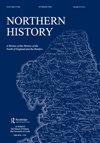The Military Estate in the North of England 1790 to 1914 – Shaped by Changing Military Priorities
IF 0.2
3区 历史学
Q2 HISTORY
引用次数: 0
Abstract
The history of policing frequently implies that military sites were created to fulfil the requirement to provide a rapid response to support the civil powers. This article acknowledges that this factor, especially in the first half of the nineteenth century. The impact is set out through a detailed examination of General Napier’s plans in response to disturbances in manufacturing towns. Care needs to be taken not to ascribe the development of the whole military estate to the fulfilment of that particular function. There were always a small number of important defensive sites in the northern landscape. But the real change in the acquisition of land for military purposes came in the decades after the Crimean War when the military estate was shaped by weaponry and the struggle to create effective training. Accommodating the army remained the dominant factor in terms of the number of military sites. These were located to recruit enough soldiers to supply Britain’s often confused priorities of securing colonial interests and defending against European threats. This article maps out those key changes in the military estate in northern England, a development often overshadowed by the focus on military strength in London and the south coast.1790年至1914年英格兰北部的军事地产——由军事优先事项的变化所塑造
警务的历史经常表明,建立军事基地是为了满足提供快速反应以支持民事权力的要求。本文承认这一因素,特别是在十九世纪上半叶。这一影响是通过对纳皮尔将军应对制造业城镇骚乱的计划进行详细审查而得出的。需要注意的是,不要把整个军事产业的发展归因于履行这一特定职能。在北部地区,总是有少量重要的防御地点。但在克里米亚战争后的几十年里,军事用地的获取发生了真正的变化,当时的军事遗产是由武器和创造有效训练的斗争所形成的。就军事基地的数量而言,容纳军队仍然是主要因素。这些基地的位置是为了招募足够的士兵,以满足英国在确保殖民利益和抵御欧洲威胁方面经常混淆的优先事项。这篇文章描绘了英格兰北部军事领域的关键变化,这一发展往往被伦敦和南海岸对军事实力的关注所掩盖。
本文章由计算机程序翻译,如有差异,请以英文原文为准。
求助全文
约1分钟内获得全文
求助全文
来源期刊

Northern History
Multiple-
CiteScore
0.20
自引率
33.30%
发文量
37
期刊介绍:
Northern History was the first regional historical journal. Produced since 1966 under the auspices of the School of History, University of Leeds, its purpose is to publish scholarly work on the history of the seven historic Northern counties of England: Cheshire, Cumberland, Durham, Lancashire, Northumberland, Westmorland and Yorkshire. Since it was launched it has always been a refereed journal, attracting articles on Northern subjects from historians in many parts of the world.
 求助内容:
求助内容: 应助结果提醒方式:
应助结果提醒方式:


